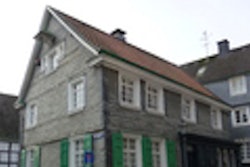
As part of its drive towards structured reporting, the German Röntgen Society (Deutsche Röntgengesellschaft, DRG) has published two new report templates for CT stone detection and conventional x-ray before hip arthroplasty. These follow the publication of a template for pancreatic carcinoma, which was included in the recently revised S3 guideline.
In this Q&A interview, the chair of the DRG's Information Technology Working Group (AGIT), Dr. Daniel Pinto dos Santos, from the Institutes of Diagnostic and Interventional Radiology at the University Hospital of Cologne and the University Hospital of Frankfurt am Main, discusses the new templates and how software manufacturers should integrate them into their technical solutions.
 Dr. Daniel Pinto dos Santos. Photo courtesy of DRG.
Dr. Daniel Pinto dos Santos. Photo courtesy of DRG.Q: What is structured reporting and why is it important?
A: Structured reporting attempts to put findings, which we otherwise formulate as free text, into a standardized form -- and to provide a kind of checklist that can be used to work through the findings. In this way, the relevant information can be recorded in a structured manner and later evaluated more easily, ensuring that all relevant information on a particular finding is included.
Q: How is AGIT involved in this area and what is new?
A: AGIT has been dealing with structured reporting for a long time. In addition to the fact that we want to draw attention to the topic, we also develop these reporting templates together with other DRG working groups (AGs) and the respective professional societies of referring physicians. Recently, we have published some new templates: one for CT stone detection and another for conventional x-ray before hip arthroplasty. These are available on our website.
Q: What is the clinical significance of the DRG report templates to date?
A: Unfortunately, the practical use of DRG report templates is not yet widespread, mainly due to the lack of suitable software solutions. Nevertheless, they are significant because they are essentially aimed at improving the quality of reports. A good example of this is pancreatic cancer. The report determines whether a patient is operable or not. A report template such as a checklist can help here and ensure that all important information is included. In this respect, our report templates have a real clinical significance, and this is also recognized by the other professional societies. I was very pleased that the revised S3 guideline on pancreatic cancer also includes the relevant DRG report template.
Q: How can software manufacturers integrate the report templates?
A: We are currently facing a turning point, and one where we absolutely have to make progress. Of course, the report templates can only be used if they are integrated into RIS workflows. We radiologists hope that RIS manufacturers will provide us with good tools in this area. The report templates themselves are freely available, with an open license. You don't have to pay anything for them, and you can use them commercially. In addition, the corresponding IHE profile was recently published in its final form, after many years in limbo. So AGIT and DRG have already laid many foundations. Now we want to take the next step together with manufacturers.
Q: Is there concrete exchange with the manufacturers about this?
A: Yes, we had a very productive and co-operative meeting with representatives of many software manufacturers at the 103rd German Radiology Congress in Wiesbaden. The aim of this was to find out in a joint exchange where there are problems on their side, what the DRG can still do, and what the manufacturers need from us. At the same time, we also wanted to make it clear to them from a user perspective what we want from them and where we think software development should go. For us radiologists, the most important thing is to be able to continue working efficiently with speech recognition software, for example. Specifically, we were able to communicate that during reporting, the movement of the mouse alone between the image and the report template must happen very frequently, and this reduces efficiency so much that meaningful use is barely possible.
We also received feedback from the manufacturers that, from their point of view, a different technical format would be easier to integrate into the respective software solutions. We will now look at this and then potentially offer both formats in parallel. Fortunately, some manufacturers have already directly offered to help with the translation between the formats. This shows once again that you can often get things moving faster if you approach each other and do things together. I am confident that this will give the initiative a good boost in the near future.
Editor's note: This is an edited version of a translation of an article published in German online by the DRG on 20 June 2022. Translation by Frances Rylands-Monk. To read the original version, go to the DRG website.



















